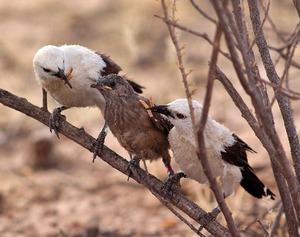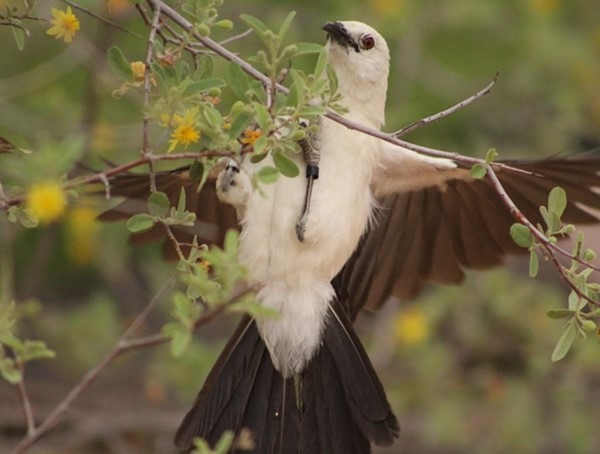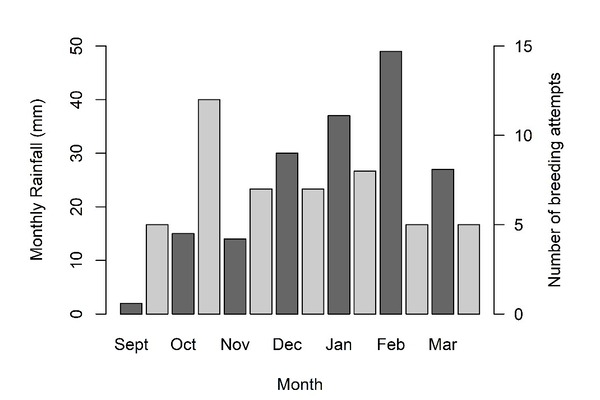 LINKED PAPER
LINKED PAPER
Camelthorn and blackthorn trees provide important resources for Southern Pied Babblers (Turdoides bicolor) in the Kalahari. Hunt, K., Marais, L., Cunningham, S.J., Ridley, A.R., Moagi, L., Rose, S., Mckechnie, A.E. & Bourne, A.R. 2023 Ibis. doi: 10.1111/ibi.13232 VIEW
Southern Pied Babblers (Turdoides bicolor) are medium-sized (60–90 g) cooperatively breeding passerines endemic to the Kalahari, a semiarid savanna region. Previous studies have shed light on the reproductive ecology and foraging behaviour of this species. They build open cup grass nests and breed during the austral summer (Ridley 2016, Bourne et al. 2020). They are primarily terrestrial foragers, searching the ground under trees and shrubs for invertebrate prey, mainly Coleoptera, Lepidoptera and Orthoptera (Ridley 2016).
However, there is little information around the extent and reliance of this species on the resources around them. They are known to nest and forage in and under Camelthorn (Vachellia erioloba) and Blackthorn (Senegalia mellifera) trees, but the overall importance of these tree species has yet to be specifically evaluated. Our study aimed to address this gap in knowledge by observing the breeding and foraging behaviour and identifying nesting site and foraging site preferences for this species for the first time.

Figure 1 Southern Pied Babbler (Turdoides bicolor) © Nicholas Pattinson.
All data for our study were collected at the Kuruman River Reserve and neighbouring properties in the southern Kalahari as part of Amanda Bourne’s PhD (Fitzpatrick Institute). A habituated population was established at the study site in 2003, and is maintained on an ongoing basis, by Assoc Prof Amanda Ridley (University of Western Australia). Most rain falls in this area between December and March as indicated by the dark grey bars in the figure below and Southern Pied Babblers initiate most nests in October each year as indicated by the light grey bars (Fig 2). This confirms that the onset of breeding in these birds is not in response to the onset of summer rainfall, as is the case for other arid-zone bird species. Instead, these birds initiate and reach peak breeding predictably in September and October each year, before the onset of the wettest part of the annual cycle between December and March.

Figure 2 At our study site in the Kalahari Desert in southern Africa, most rain falls between December and March (dark grey bars). Southern Pied Babblers (Turdoides bicolor) initiate most nests in October each year (light grey bars).
Ivlev’s electivity index was used to assess preference in this study. Throughout the breeding season, Southern Pied Babblers avoided foraging in exposed open ground, used Driedoring (Rhigozum trichotomum) in keeping with its availability in the environment and showed a clear preference for foraging in or under Camelthorn and Blackthorn trees (Fig 3). In addition, we were more likely to observe these birds foraging off the ground and, specifically, in Camelthorn canopies earlier (September and October, coinciding with the onset of breeding and peak Southern Pied Babbler nest initiation) compared to later in the breeding season (November onwards, coinciding with peak rainfall) (Fig 4). In comparison, these birds were more likely to be observed foraging in Blackthorn later in the breeding season rather than earlier (Fig 4). Thus, Southern Pied Babblers make use of these two important tree resources at different times.

Figure 3 Southern Pied Babblers avoided foraging in open ground, used Driedoring shrubs in keeping with their availability in the environment and preferentially foraged in Blackthorn and Camelthorn. Data were collected from 118 individuals across 15 different groups during observations conducted over 130 days between September 2016 and February 2019.

Figure 4 Proportion of foraging observations in a) Camelthorn trees and b) Blackthorn trees early and late in the breeding season. Southern Pied Babblers were more likely to be observed foraging in Camelthorn trees earlier in the breeding season compared to later in the breeding season, while the reverse is true for Blackthorn.
Our results demonstrate the importance of Camelthorn and Blackthorn trees for Southern Pied Babblers, thus highlighting the importance of protecting these trees to ensure the survival of this Kalahari endemic species. Camelthorns are a keystone species in the Kalahari region and their declining population numbers are concerning, for Southern Pied Babblers and for the other species that depend on them. Our results also raise the possibility that Southern Pied Babbler reproduction may be decoupled from rainfall and rather initiated according to the fruiting and flowering of the deep-rooted Camelthorn.
References
Bourne, A.R., Cunningham, S.J., Spottiswoode, C.N. & Ridley, A.R. 2020. High temperatures drive offspring mortality in a cooperatively breeding bird. Proceedings of the Royal Society B 287:20201140. VIEW
Ridley, A.R. 2016. Southern Pied Babblers: The dynamics of conflict and cooperation in a group-living society. In Dickinson, J.L. & Koenig, W. (eds) Cooperative Breeding in Vertebrates: Studies of Ecology, Evolution, and Behavior: 115–132. Cambridge, UK: Cambridge University Press.
Image credit
Top right: Southern Pied Babbler (Turdoides bicolor) © Nicholas Pattinson.
If you want to write about your research in #theBOUblog, then please see here.




